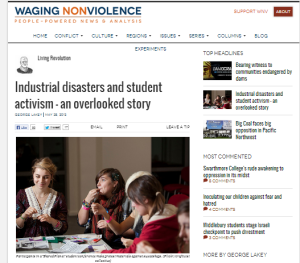Nonviolence Currents – Bridging Nonviolence and Current Events in the Classroom
A service of the Metta Center for Nonviolence
LESSON PLAN #2
Waging Nonviolence Article: Industrial disasters and student activism – an untold story by George Lakey
 Themes: labor rights, dehumanization, nonviolence, activism
Themes: labor rights, dehumanization, nonviolence, activism
Ages: 14-18 (high school)
Pre-reading activity: Ask students to skim the article and look up the words they don’t know (examples: inoculate, hermetic).
Pre-reading discussion: Ask students to share what they know about activism.
What is activism? What does it mean to be an activist? Do you identify as an activist? Why or why not? Does being an activist require specific action? Are thinking and speaking forms of activism? Why or why not? Is there student activism in your school or community?
Reading: Set aside time in class to read the article (10-15 minutes) or assign the reading for homework the night before class.
Post-reading discussion questions:
1. The article’s subtitle is “an overlooked story.” Do you agree that this story (of student activism) is overlooked? If so, why?
2. The article discusses how workers in a Dominican factory were forced to yell “I am not a human! I am an animal!” Why is that? What is the connection between dehumanization and worker’s rights? Between dehumanization and violence?
3. The article primarily talks about face-to-face activism where the students were protesting in the streets and the offices of the university. In the past few years, online activism (“clicktivism”) has been on the rise. What are the pros and cons of internet activism (such as online petition signing)? Have you participated in “clicktivism”?
Follow-up Activity: True Price 
This activity is adapted from a TED talk by Zoe Weil, The World Becomes What You Teach. As preparation for the activity, you may want to have students watch the TED talk, and read Zoe’s blog post about the True Price activity.
1. In small groups or individually, ask students to choose an item of clothing they are wearing that they will focus on for this activity. Try to be as specific as possible (material, brand, etc.) Note: You may wish to analyze one item as a class, so that students understand the process, and then have them work on it in groups or individually.
2. Have students address the first question Zoe Weil poses: What are the effects, both positive and negative, of this item on you, other people, animals, and the environment? Students can brainstorm, and if possible, do internet research to find out more specific information about the country of origin (wages, workers rights, environment, etc). Download the True Price Worksheet.
3. Next, address the second question: What alternatives would do the most good and the least harm to you, other people, animals, and the environment? (Make sure that students consider the alternative of not purchasing a new item!)
4. Ask students to make the connection from this activity to the main topic of student activism. Is “conscious consumerism” a form of activism? Why or why not?
5. What are the limitations to “conscious consumerism” and how might students create solutions to “unconscious consumerism” that can work for everyone?
6. How can one be a “conscious consumer” and still dehumanize others about their choices? Why is it important to be aware of one’s own tendencies toward dehumanization when it comes to “conscious” choices?
7. Invite students to experiment with this exercise the next time they choose to buy something.
Extension:
As a class, brainstorm local or global issues that you care about, and choose one issue for a class project to plan an awareness-raising campaign around this issue.
Photo: Students at High Tech High in Chula Vista, CA held a peace conference and created a school peace garden, 2012.
Lesson Plan Created and Developed by Stephanie Knox Cubbon and Stephanie Van Hook of the Metta Center for Nonviolence










[…] & Responsibilities Note: This activity is an adaptation of one that first appeared in our Nonviolence Currents #2 and was inspired by a TED talk by Zoe Weil, The World Becomes What You Teach. As preparation for […]